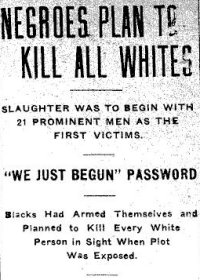| Part of the Red Summer and the Nadir of American race relations | |
 Headline in the Arkansas Gazette, October 3, 1919 | |
| Date | September 30, 1919 |
|---|---|
| Location | Hoop Spur, Phillips County, Arkansas, U.S. |
| Also known as | Elaine Massacre |
| Participants | Residents of Phillips County, Arkansas |
| Deaths | 100–237 black people,[1][2] 5 white people[3] |
| Part of a series on the |
| Nadir of American race relations |
|---|
 |
The Elaine massacre occurred on September 30 – October 2, 1919, at Hoop Spur in the vicinity of Elaine in rural Phillips County, Arkansas where African Americans were organizing against peonage and abuses in tenant farming. As many as several hundred African Americans and five white men were killed.[4] Estimates of deaths made in the immediate aftermath of the Elaine Massacre by eyewitnesses range from 50 to "more than a hundred".[5] Walter Francis White, an NAACP attorney who visited Elaine shortly after the incident, stated "... twenty-five Negroes killed, although some place the Negro fatalities as high as one hundred".[6] More recent estimates in the 21st century of the number of black people killed during this violence are higher than estimates provided by the eyewitnesses, and have ranged into the hundreds.[3][2][7] The white mobs were aided by federal troops (requested by Arkansas governor Charles Hillman Brough) and local terrorist organizations.[8] Gov. Brough led a contingent of 583 US soldiers from Camp Pike, with a 12-gun machine gun battalion.[7]
According to the Encyclopedia of Arkansas, "the Elaine Massacre was by far the deadliest racial confrontation in Arkansas history and possibly the bloodiest racial conflict in the history of the United States".[9][10]
After the massacre, state officials concocted an elaborate cover-up, claiming that blacks were planning an insurrection.[8] National newspapers repeated the falsehood that blacks in Arkansas were staging an insurrection.[8] A New York Times headline read, "Planned Massacre of Whites Today", and the Arkansas Gazette (the leading newspaper in Arkansas) wrote that Elaine was "a zone of negro insurrection".[8] Subsequent to this reporting, more than 100 African Americans were indicted, with 12 being sentenced to death by electrocution.[8] After a years-long legal battle by the NAACP, the 12 men were acquitted.[8]
Because of the widespread attacks which white mobs committed against blacks during the Red Summer of 1919, the Equal Justice Initiative of Montgomery, Alabama classified the black deaths at Elaine as lynchings in its 2015 report on the lynching of African Americans in the South.[11]
- ^ Cite error: The named reference
Walter Francis White 1995, p.49was invoked but never defined (see the help page). - ^ a b Arkansas Assembly 2017
- ^ a b Cite error: The named reference
encyclopediaofarkansas.netwas invoked but never defined (see the help page). - ^ Cite error: The named reference
rogerswas invoked but never defined (see the help page). - ^ [Ida B. Wells (Wells-Barnett, I. B.)] (1920). [The Arkansas Race Riot https://archive.org/details/TheArkansasRaceRiot/].
- ^ White, Walter F. (December 6, 1919). "'Massacring Whites' in Arkansas". The Nation. CIX (2840).
- ^ a b Whitaker, Robert (2008). On the Laps of Gods: The Red Summer of 1919 and the Struggle for Justice That Remade a Nation. New York: Random House, Inc. ISBN 978-0-307-33982-9.
- ^ a b c d e f "The white press has a history of endangering black lives going back a century". The Washington Post. 2020.
- ^ Cite error: The named reference
AKencwas invoked but never defined (see the help page). - ^ Krug, Teresa (18 August 2019). "A rural town confronts its buried history of mass killings of black Americans". The Guardian. Retrieved 19 August 2019.
- ^ Robertson, Campbell (February 10, 2015). "History of Lynchings in the South Documents Nearly 4,000 Names". The New York Times.